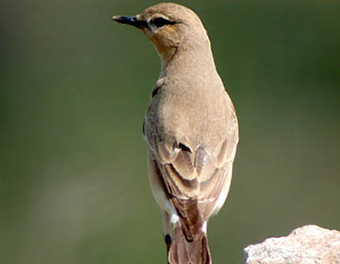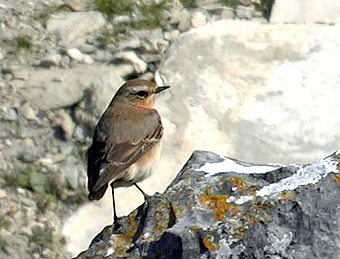Found and photographed by PARK Jong Gil on Daehuksan Island on May 01, this is the first Isabelline Wheatear to be recorded in Korea.
The species breeds in dry, mountainous areas from NE Greece (where local and scarce) east into Mongolia and NE China (sometimes breeding side-by-side with Northern Wheatear Oenanthe oenanthe in Sisluk or Eurasian Ground Squirrel Citellus citellus burrows [Igor Fefelov pers comm]). It winters across a similarly wide area that includes Africa, Arabia, and S Asia. Like other long-distance migrants it is prone to vagrancy caused by overshooting or meeting adverse weather conditions, and its occurrence in Korea has long been anticipated, especially as it has already been recorded several times in neighbouring Japan.




The images immediately reveal a rather plain looking wheatear, with black lores, and a rather poorly-marked supercilium. Although several species of (vagrant) wheatear are likely to occur in Korea, there are only two species that might resemble this individual: Isabelline Wheatear and female Northern Wheatear, the latter a species already recorded twice in Korea, both times in spring (a 1st year male on Gageo Island, May 09 2000 [Nial Moores], and a female also on Gageo on April 21 2001 [Park Jin Young]). The separation of these two rather similar species needs to be based on a range of fairly subtle structural and plumage details, most of which can be seen well in the images. It is important to note too, that separation of the two species can be significantly more difficult in autumn than in spring.
Typically, Isabelline is generally slightly larger and bulkier than Northern, with a proportionately larger head and (particularly) bill: bill lengths given in Svensson (1992) range from 18.2mm - 20.7mm for Isabelline with nominate Northern between 15.3mm - 18.8mm.
Isabelline is also longer-legged than Northern and has a subtly shorter primary projection and tail - comparative features better used with experience. The structural differences impart a different "jizz" overall, and Isabellines often stand very upright, when the shortness of the tail and the stoutness of the bill become even more obvious. This stance is often also adopted, however, by Northern - see photos below.
Although both Isabelline and female Northern share a generally plain and brown-toned plumage in spring, there are a number of diagnostic differences (some of which cannot be seen in the images). Overall, the impression of Isabelline is of a pale, fairly uniformly plumaged bird, with the darkest coloration being found on the lores (especially in males), and on the isolated alula, while female Northern shows rather more contrast, with a grayish wash to the upperparts, darkish ear coverts, brown or brownish-black lores (which sometimes appear rather "patchy"), and rather darker centers to the coverts and across the closed wing.
Identification by PARK Jong Gil of this individual as Isabelline was therefore straightforward. Sexing and ageing is rather more problematical, but based on the blackness of the lores, the presence of a weak greater covert bar, brownish centers to many of the coverts and the generally worn condition of many of the flight feathers, it is likely that this is a first summer male.
In detail, separation of Isabelline from Northern Wheatear can be based on the following features:
-
The dark tail-bar of Isabelline is distinctly wider than that of Northern. Combined with a shorter tail-length and less white on the rump anyway, in flight the white area of the tail, rump, and uppertail-coverts is far less striking on Isabelline than on Northern.
The axillaries and underwing coverts of Isabelline are whitish or pale buff, as opposed to the (usually) dark grey of Northern. Isabellines often feed rather frenetically and raise the wings far more than Northern, allowing these feathers to be seen. The upper wing can often appear more silvery too.
Whilst there is an overlap in plumage tones (the female Northern on Gageo in 2001 was very pale for example), Isabelline is usually more sandy-coloured than Northern, never shows blueish-grey tones on the upperparts (though it can show a weak grey wash e.g. on the nape sides), and has the closed wing almost concolorous with the rest of the upperparts. This is in contrast with female Northerns which have e.g. blue-grey toned scapulars, back, and sometimes mantle, more obviously dark(-centred) coverts and contrastingly darker flight feathers. The effect of an "isolated" dark alula often quoted as an important identification feature of Isabelline can be suggested by Northern too, but it is invariably obviously the darkest part of the wing in Isabelline.
The ear-coverts are never darker than the crown in Isabelline, but is often so in Northern. In the photographs above, this feature is very apparent.
The shape and the colour of the supercila are different in the two taxa. In Isabelline the supercilium often flares in front of the eye and is usually much reduced behind the eye (narrowing rapidly to a point), while in Northern it tends to be longer and more flared behind the eye. In Isabelline the fore-supercilium tends to be white or at least pale, contrasting with the often much-reduced buffy rear-supercilium - the opposite is true in Northern which usually show a buffy fore-supercilium and whiter rear. (Male Isabellines tend to show whiter supercilia and blacker loral stripe than females (with the dark portions of the tail feathers almost black) but many birds cannot be sexed reliably: Svensson, 1992).
The underparts of Isabelline tend to be concolourous - an apricot-toned wash from the ear-coverts right down to the white undertail-coverts - while again female Northern shows more contrast, often with more richly plumaged breast feathers.




References:
- Svensson, L. (1992). Identification Guide To European Passerines. (4th edition). Published by the author, Stockholm




